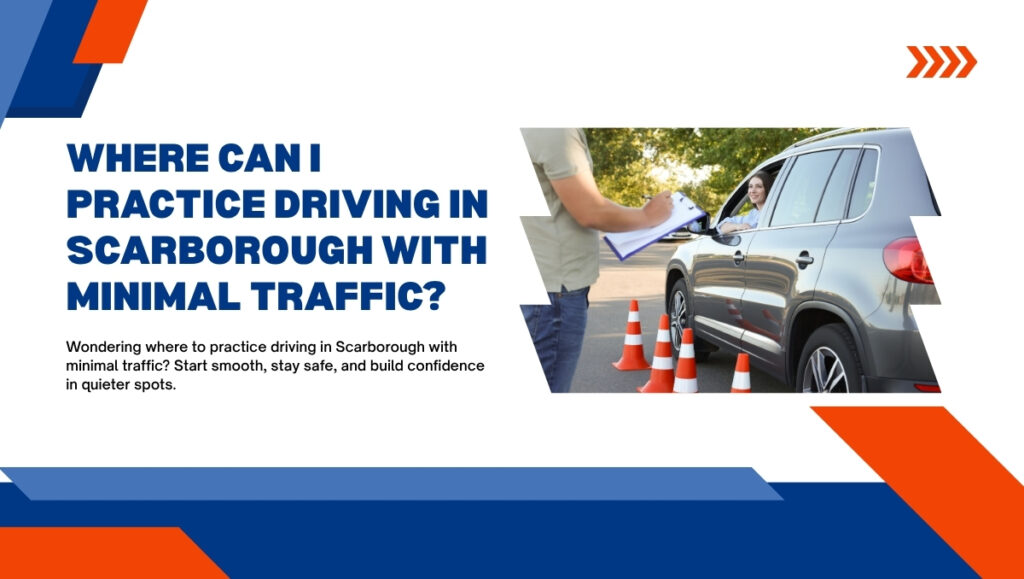Learning to drive is an important milestone, and finding the right environment for practice can make all the difference. Scarborough, a diverse district in eastern Toronto, offers many residential and commercial roads, but not all are suitable for new drivers.
High traffic volumes, fast-moving arterials, and complex intersections can overwhelm beginners and slow progress. One common question new drivers ask is: “Where can I practice driving in Scarborough with minimal traffic?”
This guide answers exactly that by explaining why practicing in low-traffic areas is effective, how to identify “minimal traffic” zones, and where to go in Scarborough for a stress-free driving experience.
By the end of this article, you will have a comprehensive roadmap to build your driving skills with confidence and control.
Defining “Minimal Traffic” Practice Areas
To select the best practice locations, first understand what “minimal traffic” means in both quantitative and qualitative terms.
Quantitative Metrics
Traffic volume is most commonly measured in vehicles per hour (VPH) or vehicles per day (VPD). For beginner drivers, aim for:
- Under 150 VPH: Typical of quiet residential crescents and cul-de-sacs outside rush hours
- Under 1,500 VPD: Most local residential streets will meet this threshold, particularly mid-morning on weekdays
- Peak vs. Off-Peak Variation: A local street that carries 200 VPH at rush hour may drop to under 50 VPH between 10 a.m. and 2 p.m.
Municipal traffic count data and crowdsourced apps can help you verify typical volumes. A street that reports less than 2,000 VPD and see fewer than 100 VPH mid-day will generally feel spacious and relaxed.
Qualitative Factors
Numbers alone do not guarantee a good practice area. Consider these qualitative attributes:
- Road Width: Streets at least seven metres wide allow beginners to correct steering without feeling boxed in.
- Sightlines: Straight stretches of 100 metres or more let you see ahead clearly and anticipate obstacles.
- Intersection Simplicity: T-intersections or short cul-de-sac loops eliminate multi-leg crossings, signal phases, and complex turn maneuvers.
- Speed Control Features: Speed humps, stop signs, and narrow entrance points reduce vehicle speeds naturally.
- Surface Quality: Smooth pavement without potholes helps maintain control during braking and turning practice.
Temporal Considerations
Traffic patterns change by the hour and day of week. To maximize calm:
- Weekday Mid-Mornings (10 a.m. to 2 p.m.): Schools are in session and commuter traffic subsides.
- Early Weekend Mornings (7 a.m. to 9 a.m.): Retail plazas and community centres remain closed or only just opening.
- Evenings After 7 p.m.: Most commercial areas quiet down, though ensure adequate street lighting.
- Avoid school drop-off (8 a.m. to 9 a.m.) and pick-up (2:30 p.m. to 4 p.m.) windows, when residential streets near schools can spike in volume.
Seasonal factors also matter. In winter, local roads may be lower priority for plowing, so verify snow-clearance schedules before venturing out.
In summer, school parking lots and community centres become excellent alternatives when academic sessions end.
Core Criteria for Selecting Your Practice Spot
Use the following five criteria as a checklist before choosing any street or lot:
Road Type and Layout
- Crescents and cul-de-sacs minimize through traffic and simplify decision-making.
- Straight collector roads with few intersections let you practice speed maintenance and lane discipline.
Parking and Maneuver Space
- Legal curbside parking or unused driveways provide safe areas for start-stop drills, parallel parking, and three-point turns.
- Ensure you are not blocking active driveways or fire hydrants.
Pedestrian and Cyclist Activity
- Avoid streets adjacent to parks, trails, or school yards during busy times.
- Select roads with minimal pedestrian foot traffic and few bicycle lanes.
Proximity and Accessibility
- Locations within a five- to ten-minute drive from home or your driving school reduce transit time and maximize wheel time.
- Good transit links can help if you share or rent a vehicle.
Seasonal and Weather Suitability
- During winter storms, choose streets that the city plows early and regularly.
- In rainy seasons, avoid areas prone to flooding or poor drainage.
- In autumn, steer clear of streets with heavy leaf debris that can hide hazards.
Where can I practice driving in Scarborough with minimal traffic?
Below are the most reliable low-traffic areas, organized by quadrant. Each entry includes street examples, unique features, and recommended drills.
West Scarborough
Woburn (South of Lawrence Avenue East)
- Streets: Nasmith Crescent, Dunrankin Drive, Galloway Road cul-de-sac
- Features:
- Continuous crescent loops with few intersecting streets
- Open sightlines of more than 150 metres on straight stretches
- Low vehicle counts (often below 1,200 VPD)
- Recommended Drills:
- Smooth acceleration and deceleration
- Maintaining lane position on gentle curves
- Curb-side stops and controlled starts
Bendale Off-Shoot Crescents (Near Bellamy Road North)
- Streets: Scarborough Golf Club Road off-shoot loops, Augustina Crescent
- Features:
- Large, semi-circular loops reduce reversing maneuvers
- Well-maintained asphalt for consistent tire feedback
- Average midday traffic under 100 VPH
- Recommended Drills:
- Parallel parking between two cones or posts
- Three-point turns with space to practice entry and exit angles
Central Scarborough
Bendale Court and Adjacent Dead Ends (East of Midland Avenue)
- Streets: Bendale Court, Eastbend Court, Parkway Court
- Features:
- True cul-de-sacs with single entry and exit points
- Minimal pedestrian activity after school hours
- Flat terrain encourages consistent speed practice
- Recommended Drills:
- Reversing in a straight line for 20 metres
- Turning into and out of driveways
L’Amoreaux Side Streets (North of Ellesmere Road
- Streets: Florence Crescent, Armstrong Crescent, Huntley Road
- Features:
- Wide shoulders and occasional parking lanes for extra room
- Moderate curves for lane-change practice
- Traffic calming features such as speed humps
- Recommended Drills:
- Changing lanes with proper mirror checks and shoulder glances
- Continuous curve driving to master steering control
East Scarborough
Highland Creek Side Streets (Off Kingston Road)
- Streets: Wilkie Crescent, Kirby Road loops, Valentine Crescent
- Features:
- Quiet due to low commercial presence
- Gentle grade changes add mild challenge for throttle control
- Ample street parking to simulate real-world parking conditions
- Recommended Drills:
- Blind spot checks before merging onto main roads
- Smooth rolling stops at stop signs
West Hill Quiet Loops (Off Morningside Avenue)
- Streets: Scarboro Crescent, Glynburn Drive, Poplar Road
- Features:
- Gently winding loops with clear sightlines
- Minimal bus traffic and no bicycle lanes
- Average daily counts below 1,000 vehicles
- Recommended Drills:
- Consistent cornering technique
- Controlled braking on downhill segments
North Scarborough
Agincourt Older Subdivisions (Near Sheppard Avenue East)
- Streets: Stuartcroft Drive cul-de-sacs, Banff Road, Devonleigh Road
- Features:
- Narrow roads under 7 metres wide for precise steering practice
- Residential speed limits of 30 to 40 km/h
- Very low pedestrian activity
- Recommended Drills:
- Slow-speed maneuvering between cones
- Tight U-turn practice
2. Milliken Park Neighbourhood Crescents
- Streets: Aldermore Drive, Lively Boulevard, Park Hunt Court
- Features:
- Long straight sections exceeding 500 metres
- Few side street intersections
- Light traffic throughout the day
- Recommended Drills:
- Maintaining a steady 40 km/h speed
- Mirror and signal discipline before turns
South Scarborough
Guildwood Residential Crescents (Off Kingston Road)
- Streets: Deslauriers Drive loops, Rowatson Road crescents, Toynbee Trail segments
- Features:
- Very low traffic, often fewer than 800 VPD
- Well-lit streets for evening practice
- Consistent pavement quality for predictable handling
- Recommended Drills:
- Parallel parking in tight spaces
- Quick lane changes around slow obstacles
Scarborough Bluffs Side Streets (Near Ellesmere Road)
- Streets: Shoreham Drive, Undercliff Drive, Sylvan Avenue
- Features:
- Scenic views can reduce learner stress
- Slight elevation changes for throttle control practice
- Moderate curves that are still forgiving for beginners
- Recommended Drills:
- Controlled stops on mild inclines
- Anticipation of curve exit points
Alternative Low-Traffic Venues
When residential streets are unavailable, weather-affected, or too dark, consider these off-street options:
Commercial Parking Lots After Hours
- Home Depot Guildwood (Eglinton Avenue East)
- Large, well-marked stalls and aisles
- Almost empty after 8:00 p.m. on weekdays and early weekend mornings
- Ideal for parking lot navigation drills and emergency stops
- Kennedy Commons Plaza (Kennedy Road & Ellesmere Road)
- Multiple retail bay entrances and exits to practice merging and turning
- Parking lot islands serve as natural obstacle courses
School and Community Centre Lots
- Woburn Collegiate Institute
- Expansive lot and multiple driveways
- Available evenings, weekends, and summer months
- Morningside Community Centre
- Marked spaces for angle parking practice
- Good lighting for dusk or early evening sessions
Industrial and Business Parks on Weekends
- Sheppard–Markham Industrial Area
- Wide industrial roads with few parked vehicles before 9:00 a.m. on Saturdays
- Opportunity to practice driving near large vehicles at a safe pace
- Military Trail Business District
- Spacious roads with minimal weekend activity
- Suitable for early morning learner sessions
Timing Your Practice: When to Go
Even the best location can feel busy at the wrong time. Plan your sessions for:
- Weekday Mid-Mornings (10 a.m. to 2 p.m.): Schools are in session and commuter traffic subsides.
- Early Weekend Mornings (7 a.m. to 9 a.m.): Before retail, recreational, and religious activities begin.
- Evenings After 7 p.m.: Most commercial and school areas quiet down; ensure good street lighting.
Avoid
- School drop-off/pick-up: 8 a.m. to 9 a.m. and 2:30 p.m. to 4 p.m.
- Evening Rush Hour: 4 p.m. to 6:30 p.m.
- Weekend Brunch Hours: 10 a.m. to noon near shopping centres and cafes.
Seasonal adjustments
- In winter, verify plow schedules; stick to main residential streets that clear first.
- In autumn, avoid leaf-packed roads that may conceal hazards.
- In summer, practice near schools during vacation when lots and roads are quieter.
Planning and Tracking Your Sessions
Structured practice leads to steady improvement. Follow these steps:
Map Your Route in Advance
- Use Google Maps in satellite and street-view modes.
- Activate live traffic layers to check current conditions.
- Save multiple routes to respond to unexpected closures or traffic spikes.
Define Clear Objectives
- Focus on one or two skills per session to avoid overload.
- Examples:
- Smooth, controlled stops within marked zones
- Parallel parking between cones or parked cars
- Consistent lane-keeping on straight stretches
Maintain a Driving Journal
Record each session:
- Date and start/end times
- Location(s) practiced
- Weather conditions and road surface notes
- Skills practiced and self-rating on a 1–5 scale
- Specific successes and areas needing improvement
Review entries weekly with your instructor or a trusted mentor.
Solicit Feedback
- Invite your supervising driver or an instructor to ride along periodically.
- Compare your journal notes with their observations.
- Adjust future session objectives based on combined insights.
Safety, Etiquette, and Legal Requirements
Even in low-traffic areas, safe and respectful driving is mandatory.
Legal Standards
- Learner (G1) drivers must be accompanied by a fully licensed driver with at least four years of experience and a zero blood alcohol level.
- Obey posted speed limits: 40 km/h or lower on local roads, 50 km/h on collector streets unless otherwise posted.
- Stop fully at all stop signs and red lights, even if no other vehicles are visible.
Courtesy and Respect
- Do not idle the engine near front doors or driveways.
- Do not block private driveways or fire hydrants.
- Maintain a polite demeanor; wave to residents if appropriate to show courtesy.
Weather-Specific Precautions
- In rain or wet conditions, increase following distance by at least 30 per cent.
- In snow or ice, reduce speeds significantly, avoid sudden inputs, and allow double the normal braking distance.
- Clear all windows, mirrors, and lights of ice or condensation before driving.
Technology to Enhance Your Practice
Modern technology can supplement real-world practice and accelerate learning.
Traffic-Camera Apps
View real-time feeds on major intersections and local roads to pick the quietest times.
Dash Cameras
Record your practice sessions for playback. Evaluate throttle smoothness, steering corrections, and speed consistency.
Mapping Tools
Use Waze or Google Maps traffic layers to predict likely congestion or closures.
Driving Simulators
Apps such as Driving Test Success or OnRoad let you rehearse specific Scarborough routes virtually, helping you form mental maps.
Transitioning to Busier Environments
As your confidence grows, you will want to challenge yourself with more complex traffic situations. Use a gradual approach:
Quiet Collector Roads
Example: Brimley Road north of Lawrence Avenue. Practice lane changes, signal timing, and maintaining proper speed.
Minor Arterials
Example: sections of Kennedy Road or Markham Road during off-peak hours. Introduce bus lanes, multi-phase signals, and moderate traffic.
Commercial Corridors
Example: Scarborough Town Centre area before 10 a.m. Work on merging into shopping plaza traffic and handling drive-through lanes.
Mixed Traffic Scenarios
Include cyclists, pedestrians, and delivery vehicles. Practice scanning for crosswalks, adjusting distances, and anticipating lane shifts.
Always return to your low-traffic zones whenever you feel overwhelmed. Mastery comes from repetition in a controlled progression.
Conclusion
Mastering driving begins in low-traffic environments where you can focus on developing fundamental skills without stress.
Scarborough offers a wealth of quiet crescents, side streets, parking lots, and industrial parks that can become your personal training grounds.
By defining clear criteria, choosing the right times, using planning and tracking tools, and respecting safety and legality, you can accelerate your progress from a cautious beginner to a confident road user.
Keep these key takeaways in mind:
- Quantify and qualify your practice locations.
- Select streets and venues with minimal interruptions.
- Time your sessions for the quietest hours.
- Maintain a journal and seek feedback.
- Use technology to plan and review.
- Progress gradually to busier roads.
Your journey to confident, safe driving starts now. Pick your first location, plan a session, and note your observations.
Then share your favourite quiet Scarborough practice spots with other learners. Together, you will build a community of well-prepared drivers. Good luck, and drive safely!






